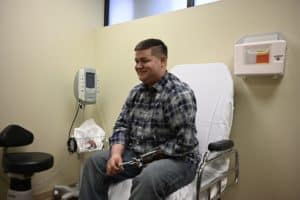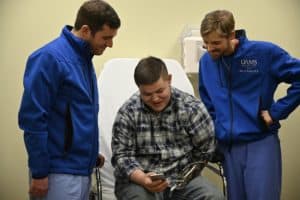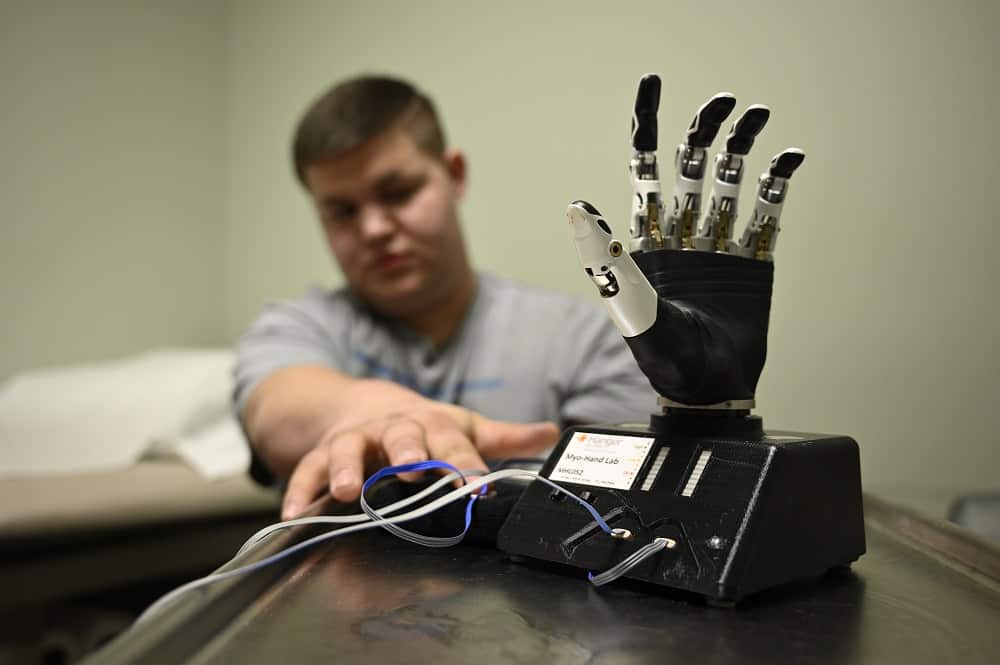Teen Gets Body-Powered Arm at UAMS Amputee Clinic
| It was a great day for fishing in May almost two years ago when Bryce Cook, of Arkadelphia, who had just turned 16, headed toward the river on a side-by-side to pursue one of his favorite pastimes.
By all accounts – his own, witnesses, subsequent police investigation – he wasn’t going fast when, as the road went from pavement to dirt, the right rear tire struck a boulder that had been left after grading work on the road. He cut the turn hard to correct, but when the vehicle started to flip, he instinctively threw up his left arm to brace himself. That’s when it caught in the roll bar.
“I realized something was wrong. I thought I’d broken my arm because it hurt pretty bad right as it happened,” Bryce, now 17, recently recalled.
Bryce immediately realized his danger with no one nearby for help. He went to reach for his phone with the arm he’d stuck out only to immediately realize it was gone.
“My phone was in my left pocket, because I’m left-handed, but I couldn’t reach it. I remember my arm being gone.”

Bryce Cook, who lost his left arm in a 2018 accident, chats while he awaits an appointment with orthopaedic surgeons at the amputee clinic.
He managed to work the phone out of his pocket and hold it with his chin to dial his parents, but there was no cell service. A nearby resident, who happened to be the janitor at Bryce’s old middle school and who lives in one of the last houses he’d passed, heard Bryce’s calls for help and came running,. The man’s wife called an ambulance. As the ambulance rushed to the airport, a helicopter was called to fly Bryce to Little Rock.
The accident ultimately brought Bryce to UAMS Orthopaedics, which last year launched a one-stop multidisciplinary clinic for upper extremity amputees under fellowship-trained surgeons Mark Tait, M.D. and John Bracey, M.D.
In the time since, Bryce has been fitted with a body-powered prosthetic, which allows him to use body movement to move his arm at the elbow or, by locking the arm with a different movement, to open and close a claw for gripping and lifting.
“When you have amputation above the elbow it makes it a little more difficult in regards to prosthetic planning because you need to replace more joints,” said Bracey. “You not only replace hand joints but have to replace elbow bending and extension, too.”
“The reason we started the amputee clinic is that each patient is very individualized,” added Tait. “So, depending on their handedness, what profession they do, the things they want to be able to do with their prosthetic, you really have to tune that to the patient.”
That tuning has proved invaluable as Bryce has moved on from his accident. He went to homeschooling to finish high school and graduated a year early. He’s now in his second semester of college studying welding.
“I wanted to go into the military, but things happened. So I figured I could still weld, because I knew of people who were one-armed welders. It seemed like something I could do, and I really liked it,” he said.
As he’s studied, his classmates have all rallied to help figure out how to adapt two-handed tasks into techniques that will work for Bryce. However, the young student and his family are hoping technology will empower him further. They hope to get a new prosthetic that will use sensors to detect muscle impulses and translate those into robotic movement.
“There’s some meaningful benefit to the reconstructive surgery we’re doing for amputees. You take the nerves that used to go to the hand and transfer them into new muscles,” said Tait. “Not only does this help with some phantom pain in the arm, but it can also help make a robotic prosthetic more functional.”

Bryce shows surgeons Mark Tait, M.D., and John Bracey, M.D., a video of him using his prosthetic to adapt to a new welding technique.
“But patients have to learn how to use it. So you take a computer, which has electrodes that you can place on top of the skin, and the patient can think about closing their hand and that will now fire a new muscle in their arm, and they can see an image or model of a hand closing.” Said Bracey. “We’re lucky in that we’re one of the few places that has the device and the computer program to do this type of training.”
Bryce is enthusiastic to train for it while his family raises funds to pursue the new robotic prosthetic, which is not covered by insurance.
“What’s cool about it is that, while I’m trying to weld something, I won’t have to move my whole body to weld. I’d just have to move one muscle, and it won’t get it in the way while I’m welding. It’ll help a lot.”
Meanwhile, he’s adapted to his new reality and staying positive about his circumstances.
“It makes a big difference when you don’t have an arm to do little things like holding a pot and stirring while cooking,” he said. “It was a very serious thing that happened, and it was very traumatic. But I’ve always been a really happy person and a get-up-and-go kind of guy. So I wasn’t going to change that or let it change me. I think it helped me for the better and made me realize a lot of different things and that life is precious and we can’t take it for granted.”
